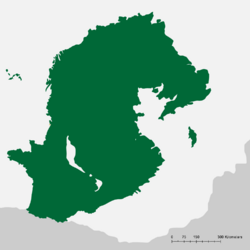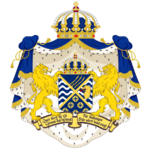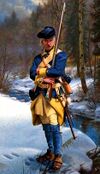Vermrike
The Great Realm of Vermrike Stordömet Värmrike | |
|---|---|
| Motto: "Över berg og sjö, gjenom dal og lund. För konungen står våret land enigt." (tr.) "Over mountains and lakes, through valley and grove. For the king our nation stands united." | |
| Greater Coat of Arms | |
 | |
| Capital and largest city | Hovsborg |
| Official languages | Vermish |
| Demonym(s) | Vermish |
| Government | Unitary parliamentary constitutional monarchy |
• King | Anskar XI |
| Kjell-Erik Fågelklo | |
| Legislature | Riksdagen |
| Establishment | |
• TBD | TBD |
• TBD | TBD |
• TBD | TBD |
• TBD | TBD |
• TBD | TBD |
• TBD | TBD |
• TBD | TBD |
• TBD | TBD |
• TBD | TBD |
| Area | |
• | [convert: invalid number] |
| Population | |
• Estimate | |
• 2022 census | 13,277,625 |
• Density | [convert: invalid number] |
| GDP (PPP) | 2021 estimate |
• Total | |
• Per capita | |
| GDP (nominal) | 2017 estimate |
• Total | |
• Per capita | |
| Gini (2017) | medium (28th) |
| HDI (2020) | very high (26th) |
| Currency | Vermish Daler (VED) |
| Date format | yyyy/mm/dd |
| Driving side | right |
| Calling code | +11 |
| Internet TLD | .vr |
Vermrike, officially The Great Realm of Vermrike (Vermish: Stordömet Värmrike) is a country on the Vermish Peninsula in TBD. Vermrike is a constitutional monarchy and a parliamentary democracy, with legislative power vested in the 549-member unicameral Riksting. It is a unitary state, currently divided into 28 provinces and 311 municipalities. Vermrike maintains a social welfare system that provides universal health care and tertiary education for its citizens. Vermrike has a developed, industrialized economy with a high standard of living and high personal wealth, coupled with low income inequality, as well as a robust welfare system.
History
Ancient History (30,000 BC - 0 AD)
The ancient peoples of Vermrike were skilled hunters, relying on their knowledge of the land and its inhabitants to procure sustenance. The tribes lived a nomadic lifestyle, following the migrations of their prey and adjusting their dwellings accordingly. They would erect temporary shelters using materials found in the environment, such as animal hides and branches. These structures provided protection from the elements and served as a gathering place for the tribe. While these tribes primarily relied on hunting and gathering, there were early signs of a transition towards limited agriculture during the later part of this period. They experimented with cultivating crops like barley and flax, taking advantage of favorable growing conditions near river valleys. This shift towards a more settled lifestyle would lay the foundation for future agricultural advancements in Vermrike.
The earliest written record from Vermrike, dates back to approximately 800 BC. This period marks the transition from prehistoric times to the beginning of recorded history in the region. The ancient people of Vermrike developed a script known as "Värmarún" to represent their language in writing. The Värmarún script consisted of angular characters known as runes, which were typically carved or inscribed on various surfaces, such as stones, wood, or bone. The language used in the earliest written records of Vermrike would have been an ancient form of old Vermish.
During the period around 500 BC to 0 AD, Vermrike experienced a turbulent era known as the Age of Old Lords. This time was marked by intense power struggles as rival lords vied for control over the land. These lords, each ruling over their respective territories, sought to expand their influence and dominion, often resorting to warfare and strategic alliances. The battles among the old lords were not merely mortal conflicts but were believed to be imbued with divine significance. In this time of uncertainty, the people of Värmrike turned to seeking the assistance and favor of the gods. While the events and characters in these legends may have been exaggerated or embellished over time, they played a significant role in shaping the cultural and religious identity of the region. As the faith and religion of Vermrike developed in later periods, these ancient tales became revered myths and foundational narratives, helping to explain the origins of the world, the divine order, and the purpose of mortal existence.
The First Major Settlement (0 - 500)
During the period from approximately 150 AD to 300 AD, significant developments unfolded in Vermrike as the first larger kingdom of the Braets began to form. The Braets, a Vermish folk who inhabited the region around the lake called "Brätten," played a pivotal role in this transformative era. At the heart of this burgeoning kingdom was King Dagmund, a revered figure in Vermrike's history. King Dagmund is known for establishing the old town of Bjaurka, which would become Vermrikes first major settlement.. It is unclear if Dagmund actually existed, but it is known for a fact that several kings ruled over the area during this time. Bjaurka reached its golden age during the period from approximately 220 AD to 500 AD. The city's rise to prominence was also closely tied to the Braet kingdom's expansion and influence in Vermrike. As the Braet kingdom grew in strength, Bjaurka emerged as its political and administrative center. The king and the ruling elite resided in Bjaurka, shaping the kingdom's policies and forging alliances with neighboring realms. However, the glory of Bjaurka began to fade in the centuries that followed and by the 10th century AD, the town had fallen into obscurity.
The Great Unification (1650-1720)
Placeholder
Placeholder
Geography
The geography of Vermrike is varied, from mountains in the north, to the low and flat areas in the south. Most of the population in the nation live in the more temperate southern regions, with the northern parts having long, cold, winters.
The warmest temperature ever recorded in Vermrike is 37.0 °C in Brumundum in 1994. The coldest temperature ever recorded is −59.2 °C in inland Merendelskog in 2009. The coldest month was January 1976 in Merendelskog with a mean of −30.6 °C
Administrative divisions
Provinces
| Name | Capital | Population |
|---|---|---|
| Slage | 360,550 | |
| Nockaborg | 446,200 | |
| Västerholm | 412,500 | |
| Vallinge | 112,319 | |
| Glimmeå | 229,611 | |
| Käffle | 200,519 | |
| Lunneborg | 31,419 | |
| Simonshus | 903,800 | |
| Skromåfors | 601,131 | |
| Gustavsfors | 331,080 | |
| Älvbro | 412,033 | |
| Askarstad | 261,005 | |
| Minnern | 112,496 | |
| Hovsborg | 2,914,600 | |
| Lauritzslott | 514,800 | |
| Ragnarsborg | 180,449 | |
| Erikstad | 334,991 | |
| Braeteborg | 1,811,431 | |
| Malmstad | 866,401 | |
| Nyborg | 1,310,110 | |
| Gräddinge | 710,880 | |
| Brumundum | 219,300 |
Economy
Services
Media
Title Published Format Est. Orientation Notes Digerposten Daily Web and Print 1836 Conservative, Pro-democracy The oldest newspaper still in operation.




